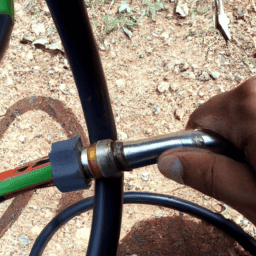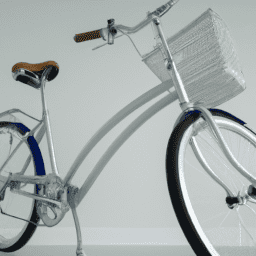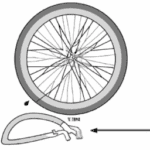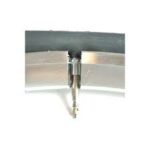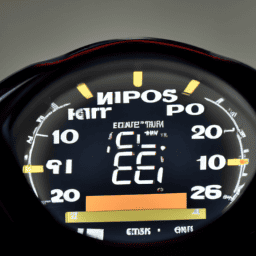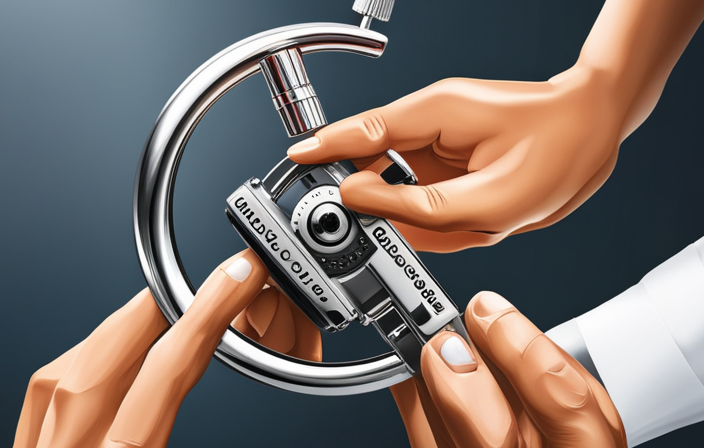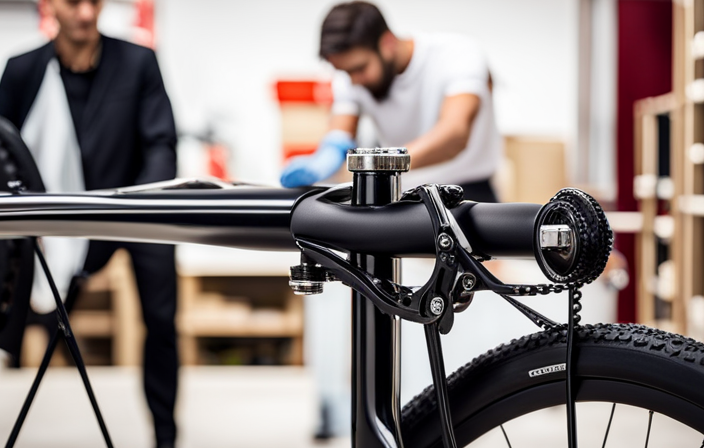Having trouble pumping up your bike tire with a presta valve? Fear not, you’re in good company. A lot of bikers find this particular valve daunting, yet mastering the proper method can simplify the process, allowing you to quickly inflate your tire and hit the road again.
Before we get started, make sure you have all the necessary materials. You’ll need a pump with a presta valve adapter, a presta valve cap, and of course, your bicycle tire.
Once you have everything ready, it’s time to prepare the valve and inflate the tire. Follow these steps carefully, and you’ll be back to cycling in no time.
Key Takeaways
- Choose a pump with a dual valve head that fits snugly onto the Presta valve stem.
- Prime the valve by pressing down on the small metal tab on top of the valve stem before inflating.
- Use a pressure gauge to ensure proper inflation and check the sidewall of the tire for recommended pressure range.
- Proper valve maintenance is crucial, including loosening the locking nut at the base of the valve stem and maintaining the valve cap to prevent it from getting stuck.
Gather Your Materials
You’ll need to gather your materials before you can start, so make sure you have everything you need. First and foremost, you’ll need a pump that’s compatible with a Presta valve. Choosing the right pump is crucial since not all pumps have the necessary valve head to fit a Presta valve.
Look for pumps with dual valve heads that can accommodate both Presta and Schrader valves. Understanding valve compatibility is also important. Presta valves are narrower and longer than Schrader valves, so the pump head needs to fit snugly onto the valve stem to avoid air leaks.
Make sure you have a pump with a Presta-specific head or an adapter that can be screwed onto the pump head. Once you have secured the right pump and adapter, you can move on to preparing the valve for inflation.
Prepare the Valve
To prepare the valve for inflating your bike tire with a presta valve, you need to follow three key steps.
First, loosen the locking nut on the valve stem by turning it counterclockwise.
Second, unscrew the valve cap by twisting it counterclockwise until it comes off completely.
And finally, prime the valve by pressing down on the small metal tab on the top of the valve stem to release a small burst of air.
By following these steps, you’ll ensure that your valve is ready for inflating your bike tire with ease and accuracy.
Loosen the Locking Nut
First, proper valve maintenance is key to ensuring that your bicycle tire is inflated efficiently. There are two types of valve stems commonly found in bicycle tires: the Presta valve and the Schrader valve.
The Presta valve is typically found on high-performance bicycles, while the Schrader valve is more commonly used on low-end bicycles. When inflating a bicycle tire with a Presta valve, it’s important to prepare the valve before proceeding.
To prepare the valve, start by loosening the locking nut. This nut is located at the base of the valve stem and is used to secure the valve to the rim. To loosen the nut, turn it counterclockwise with your fingers. Be gentle, as overtightening or undertightening the nut can cause air leaks or damage to the valve stem.
Once the nut is loose, you can move on to the next step: unscrewing the valve cap. Now that you have loosened the locking nut, it’s time to move on to the next step. Unscrew the valve cap by turning it counterclockwise with your fingers. This will expose the valve core, which is the part of the valve that allows air to flow into the tire.
With the valve cap removed, you’re ready to attach your pump and begin inflating the tire.
Unscrew the Valve Cap
Once the locking nut is loosened, have you ever wondered what’s next in inflating your bike tire efficiently? Simply unscrew the valve cap using your fingers to expose the valve core. The valve cap is a small, but important component that ensures your tire stays inflated and prevents debris from entering the valve. However, it is not necessary to use the valve cap every time you inflate your tire. In fact, some cyclists prefer to remove it altogether to make inflating their tires quicker and easier.
If you choose to remove the valve cap, be sure to keep it in a safe place where it won’t get lost. Additionally, it’s important to maintain the valve cap to prevent it from getting stuck or becoming difficult to remove. You can do this by cleaning it regularly and applying a small amount of lubricant to the threads. Alternatively, you can replace the valve cap with a different type of cap or even a decorative one to add some personality to your bike. Now that you’ve unscrewed the valve cap, it’s time to prime the valve by briefly pressing down on the valve core to release any air trapped inside before attaching the pump.
Table: Valve Cap Alternatives and Maintenance
| Valve Cap Alternatives | Valve Cap Maintenance |
|---|---|
| No cap | Clean regularly |
| Decorative cap | Apply lubricant to threads |
| Different type of cap | Store in a safe place |
With these alternatives and maintenance tips, you can ensure that your valve cap remains functional and that you can inflate your tire quickly and easily. Now, let’s move on to priming the valve.
Prime the Valve
After unscrewing the valve cap, it’s important to prime the valve before inflating your bicycle tire with a Presta valve.
Priming the valve involves pressing down briefly on the core to release any trapped air. This ensures that the valve is open and ready to receive air from the pump.
Failure to prime the valve can result in air being trapped in the valve, making it difficult to inflate the tire.
Valve maintenance is crucial to ensure the longevity of your Presta valve. One of the most common mistakes people make when inflating their bicycle tire is failing to prime the valve. This can result in damage to the valve and make it difficult to inflate the tire.
It’s important to remember to prime the valve before inflating the tire to avoid any unnecessary complications. With the valve primed, you can now move on to the next step of inflating the tire.
Inflate the Tire
To pump up the tire, simply attach the pump nozzle to the valve and give it a good squeeze like you’re giving a high five to a friend. Make sure the nozzle is securely attached to the valve, as any air leaks will result in improper inflation.
Inflating the tire with the correct pressure is crucial for optimal performance and safety. Check the sidewall of the tire for the recommended pressure range, and use a pressure gauge to ensure the tire is inflated within that range. Overinflation can cause the tire to explode, while underinflation can result in poor handling and increased risk of flat tires.
Once you have reached the proper pressure, remove the pump by unscrewing it from the valve. Make sure to do this carefully, as any sudden movements can cause air to leak out of the tire. Double-check the valve to make sure it is tightly closed to prevent any air from escaping.
Your tire is now ready to hit the road!
Remove the Pump
Gently unscrew the pump from the valve while making sure not to jostle the bike, allowing the air to remain inside the tire. Proper pump attachment is crucial to avoid damaging the valve.
When removing the pump, make sure to hold onto the valve stem with one hand while unscrewing the pump with the other hand. This will prevent the valve from being pulled out of the tube and causing a flat tire. Avoiding valve damage is important to ensure the longevity of your bike’s tires.
When removing the pump, be careful not to bend or twist the valve stem. This can cause the valve to become misaligned or even break off, rendering the tire useless. Once the pump is removed, give the tire a quick squeeze to ensure it feels firm.
This will indicate that the tire is properly inflated and ready for use.
Test the Tire
So, you think you’re ready to hit the road? Well, give that rubber buddy a good squeeze to make sure it’s not going to let you down.
It’s important to ensure that your tire is properly inflated before heading out on your ride. Proper tire pressure not only ensures a smooth and comfortable ride, but it also helps to prevent tire damage and punctures.
To test the tire, press down on the center of the tread with your thumb. If the tire feels firm and doesn’t give much, it’s likely properly inflated. If it feels soft or squishy, it’s time to pump it up.
Additionally, inspect the tire for any signs of damage such as cracks, cuts, or bulges. If you notice any of these, it’s best to replace the tire before heading out on your ride.
Taking these steps to test your tire before riding can help to ensure a safe and enjoyable cycling experience.
Frequently Asked Questions
Can I use a pump with a Schrader valve to inflate a tire with a Presta valve?
You will need a valve adapter to inflate a tire with a presta valve using a pump with a schrader valve. Pump compatibility is not an issue, but without the adapter, the valve will not seal properly.
What is the maximum pressure that a Presta valve can handle?
You need to be cautious while inflating your bike tire as Presta valve can burst at high pressure. The maximum pressure for Presta valve is around 120 psi and valve stem sizes vary for different bikes.
How often should I inflate my bicycle tires?
It is important to regularly check and maintain proper tire pressure for optimal performance and safety. Signs of wear and tear, such as cracks or bulges, should also be checked for. Inflate tires accordingly.
What should I do if the Presta valve is leaking air while inflating the tire?
If air is leaking from the Presta valve while inflating your tire, it could be due to issues with the valve core or seal. Troubleshooting leaks and proper valve maintenance can help prevent this. Don’t panic, just take action.
Can I use a CO2 cartridge to inflate a tire with a Presta valve?
Yes, you can use a CO2 cartridge for inflation, but it requires proper maintenance of Presta valves. Ensure the valve core is tight and use a regulator to prevent overinflation. Be cautious as it can freeze skin and damage tubes.
Conclusion
Congratulations! You’ve successfully inflated your bicycle tire with a Presta valve!
It may seem daunting at first, but with the right materials and technique, you can quickly and easily inflate your tire to the desired pressure.
As you remove the pump and test the tire, take a moment to appreciate the feeling of a properly inflated tire.
The smooth ride, the confident handling, and the sense of accomplishment all make it worth the effort.
You may even feel like you’re flying down the road with the wind in your hair (okay, maybe that’s a bit of a hyperbole, but you get the idea).
Remember, proper tire pressure is crucial for both performance and safety.
So, whether you’re a seasoned cyclist or a beginner, take the time to learn how to inflate your tire with a Presta valve and make it a regular part of your cycling routine.
Happy riding!
